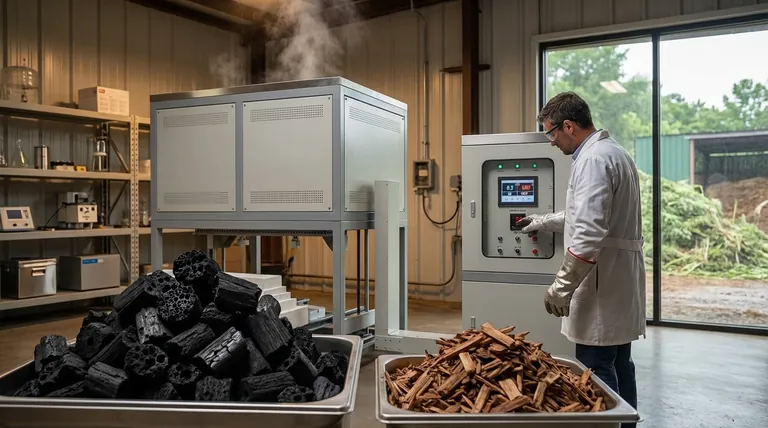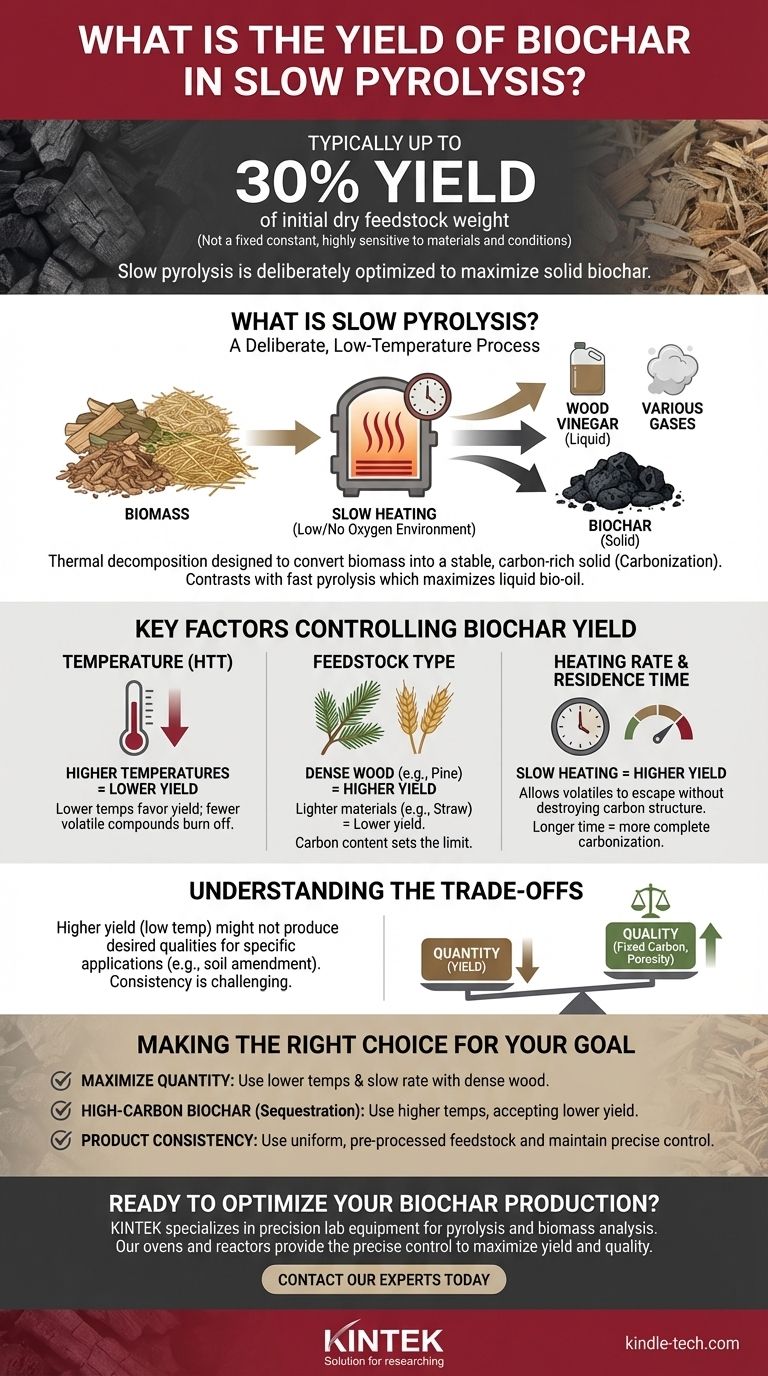Under slow pyrolysis conditions, the yield of biochar is typically up to 30% of the initial dry feedstock weight. This figure is not a fixed constant but rather the upper range of what is commonly achieved. The actual output is highly sensitive to the specific materials used and the precise conditions under which the process is run.
The core principle to understand is that slow pyrolysis is a process deliberately optimized to maximize the solid biochar product. While a 30% yield is a standard benchmark, achieving it—and creating a product with the right properties—depends entirely on controlling a few key variables.

What is Slow Pyrolysis?
Slow pyrolysis is a thermal decomposition process designed to convert biomass into a stable, carbon-rich solid known as biochar.
A Deliberate, Low-Temperature Process
The process involves heating organic material, or biomass, at a relatively slow rate in an environment with little to no oxygen. This lack of oxygen is critical; it prevents the material from combusting (burning) and instead causes it to break down into solid, liquid, and gas components.
Maximizing Solid, Not Liquid, Output
This method is also known as carbonization because it emphasizes the creation of a solid charcoal product. This contrasts sharply with fast pyrolysis, which uses high temperatures and rapid heating to maximize the liquid (bio-oil) yield. The main co-products of slow pyrolysis are a liquid known as wood vinegar and various gases.
The Key Factors Controlling Biochar Yield
Achieving the optimal biochar yield is a matter of precise control. Several interconnected factors determine how much solid product is left after the process is complete.
The Dominant Role of Temperature
The highest treatment temperature (HTT) is the single most influential factor. Lower temperatures generally favor higher biochar yields because fewer volatile compounds are burned off. As the temperature increases, the yield of biochar decreases while the production of liquids and gases increases.
The Influence of Feedstock
The type of biomass used has a direct impact on the final yield. Denser, wood-based feedstocks like pine wood often produce more biochar than lighter, less dense materials like wheat straw or green waste. The chemical makeup of the feedstock, particularly its carbon content, sets the upper limit for potential yield.
Heating Rate and Residence Time
True to its name, slow pyrolysis relies on a slow heating rate. This gives volatile components time to escape without violently breaking down the carbon structure of the biomass, thus preserving the solid char. The longer the material is held at the peak temperature (residence time), the more complete the carbonization process will be.
Understanding the Trade-offs
Simply maximizing yield is not always the primary goal. The intended application of the biochar often dictates a trade-off between the quantity produced and its specific characteristics.
Yield vs. Quality
The conditions that maximize yield (e.g., lower temperatures) may not produce biochar with the desired qualities. For example, creating biochar with a higher fixed carbon content or specific porosity for soil amendment might require higher temperatures, which would inherently reduce the overall yield.
The Challenge of Consistency
Because the output is so dependent on feedstock and process conditions, producing a perfectly consistent, "tailor-made" biochar can be challenging. This variability makes it difficult to clearly define a standard market price and requires careful quality control for specific applications, such as improving soil fertility.
Making the Right Choice for Your Goal
The optimal process parameters depend entirely on what you want to achieve with the final product.
- If your primary focus is maximizing the sheer quantity of biochar: Use lower process temperatures and a slow, controlled heating rate with a dense, woody feedstock.
- If your primary focus is creating a high-carbon, stable biochar for sequestration: You will likely need to use a higher peak temperature, accepting a slightly lower yield to drive off more volatiles and increase carbon concentration.
- If your primary focus is product consistency for a specific application: Prioritize using a uniform, pre-processed feedstock and maintaining precise, repeatable control over the temperature and residence time.
Ultimately, controlling the slow pyrolysis process allows you to engineer biochar not just for maximum yield, but for a specific purpose.
Summary Table:
| Factor | Impact on Biochar Yield |
|---|---|
| Temperature | Lower temperatures increase yield; higher temperatures decrease it. |
| Feedstock Type | Dense, woody biomass (e.g., pine) yields more than lighter materials (e.g., straw). |
| Heating Rate | Slow heating rates preserve carbon structure, maximizing solid yield. |
| Residence Time | Longer times allow more complete carbonization, affecting final yield and quality. |
Ready to optimize your biochar production? KINTEK specializes in precision lab equipment for pyrolysis and biomass analysis. Whether you're researching feedstock efficiency or scaling up production, our ovens and reactors provide the precise temperature control and consistency you need to maximize yield and quality. Contact our experts today to find the perfect solution for your laboratory's needs!
Visual Guide

Related Products
- Laboratory Muffle Oven Furnace Bottom Lifting Muffle Furnace
- 1800℃ Muffle Oven Furnace for Laboratory
- 1400℃ Muffle Oven Furnace for Laboratory
- 1700℃ Muffle Oven Furnace for Laboratory
- 1400℃ Laboratory Quartz Tube Furnace with Alumina Tube Tubular Furnace
People Also Ask
- Why do we need to use properly some of the laboratory apparatus in the laboratory? The Foundation of Safe and Accurate Science
- Does melting point ever change? Unlock the Secrets of Pressure and Purity
- Do different liquids melt at different rates? Unlock the Science of Melting Points and Material Properties
- What are the factors affecting the rate of melting process? Master Heat Transfer for Faster Results
- What is the burnout cycle on a furnace? Stop This Destructive Overheating Pattern Now



















